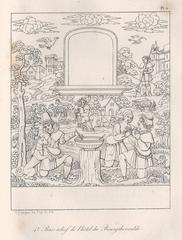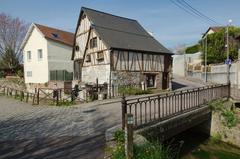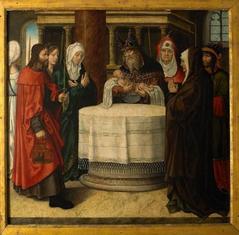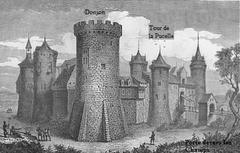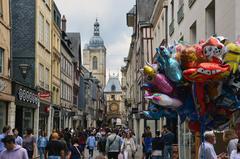Cimetière Monumental de Rouen: Visiting Hours, Tickets, and Historical Significance in Rouen, France
Date: 15/06/2025
Introduction
The Cimetière Monumental de Rouen stands as one of Rouen’s most historically and culturally significant landmarks, offering visitors a journey through nearly two centuries of social, artistic, and architectural heritage. Established in 1828 and inspired by Paris’s renowned Père Lachaise Cemetery, this monumental site was designed to provide a dignified resting place for Rouen’s burgeoning bourgeoisie and elite, reflecting the city’s evolving urban and cultural landscape. Its layout, featuring broad tree-lined avenues, Egyptian-inspired entrances, a classical chapel, and a monumental cross, harmoniously blends architecture with the natural topography (Wikipedia; Rouen Histoire; dvlparcours.mouvement-europeen76.eu).
Beyond its architectural grandeur, the cemetery is a vibrant cultural mosaic, reflecting Rouen’s social stratifications, religious diversity, and historical memory. Portions dedicated to Catholics, Protestants, Jews, and secular individuals demonstrate its multi-confessional inclusivity. Monuments and graves of notable figures—including Gustave Flaubert, Marcel Duchamp, and François-Adrien Boieldieu—offer intimate connections to the city’s artistic and intellectual legacy. Memorials for victims of conflicts such as the Franco-Prussian War and the World Wars highlight the cemetery’s role as a space of remembrance (Visiterouen.com; Actu.fr; rouen.fr).
Visitors can explore a rich tapestry of funerary art—neoclassical, neo-Romanesque, and Art Nouveau styles abound, featuring symbolism such as angels, laurel wreaths, and butterflies. The cemetery’s serene atmosphere, mature trees, and seasonal blooms create a peaceful environment for reflection and discovery.
Open daily with free admission, the cemetery provides practical amenities and accessibility options, although the natural hillside terrain may present some challenges. Guided tours—including special candlelit evening visits—offer enriching insights into the site’s history, art, and notable burials. Conveniently located near key Rouen attractions such as the Rouen Cathedral and Musée des Beaux-Arts, the cemetery is an essential stop for anyone interested in French heritage (en.visiterouen.com; petitfute.com).
In 2019, the cemetery was awarded the prestigious “Cimetière remarquable d’Europe” label, affirming its status as an open-air museum and a living repository of Rouen’s collective memory (leparisien.fr).
Table of Contents
- Introduction
- Historical Overview and Founding Vision
- Social Dynamics and Architectural Evolution
- Notable Burials and Cultural Significance
- Funerary Art and Symbolism
- Memorialization and War Memorials
- Visiting Information: Hours, Tickets, and Accessibility
- Guided Tours and Special Events
- Navigating the Cemetery
- Travel Tips and Nearby Attractions
- Practical Visitor Advice
- Frequently Asked Questions (FAQ)
- Conclusion
- References
Historical Overview and Founding Vision
Conceived in the early 19th century, the Cimetière Monumental de Rouen was modeled after Paris’s Père Lachaise Cemetery, aiming to provide a dignified final resting place for Rouen’s elite (Wikipedia; Rouen Histoire). Under the guidance of M. de Martainville, the city council selected the côte des Sapins for development. Architect Charles-Félix Maillet du Boullay designed the site to mirror the city’s own street plan. Officially opened in 1828, the cemetery set a new standard for urban burial grounds.
Social Dynamics and Architectural Evolution
Initially exclusive and costly, the cemetery soon became a prestigious site reflecting Rouen’s social hierarchies. Its layout—spanning approximately ten hectares—features broad avenues and around 22,000 graves (Visiterouen.com). Funerary art ranges from neoclassical mausoleums to Art Nouveau tombs, with memorials commemorating local tragedies and historical events.
The cemetery is divided into sections for Catholics, Protestants, Jews, and non-believers, expressing Rouen’s inclusivity. Notably, the cemetery pioneered cremation in France, with its own crematorium built in the late 19th century, defying the Catholic Church’s early prohibitions (dvlparcours.mouvement-europeen76.eu).
Notable Burials and Cultural Significance
The Cimetière Monumental de Rouen is the final resting place for many prominent figures, including:
- Gustave Flaubert (author of “Madame Bovary”)
- Marcel Duchamp (influential artist)
- François-Adrien Boieldieu (composer)
- Charles Verdrel (mayor)
- James Barker (industrialist)
- The Ganon Family (Holocaust victims)
(Actu.fr)
These graves provide a window into the city’s cultural legacy and are frequently visited by admirers and researchers.
Funerary Art and Symbolism
The cemetery is a showcase of funerary art in styles ranging from neoclassical and neo-Romanesque to eclectic and Art Nouveau. The central chapel features a classical façade, neo-Romanesque apse, and dome, now housing a columbarium (dvlparcours.mouvement-europeen76.eu).
Common motifs include:
- Angels and cherubs: Guardianship, spiritual ascent
- Urns with veils: Mourning and the soul’s passage
- Broken columns: A life cut short
- Laurel wreaths: Victory over death
- Clasped hands: Unity and remembrance
These symbols reflect the beliefs and artistic trends of their eras. Epitaphs, such as Marcel Duchamp’s famous “D’ailleurs, c’est toujours les autres qui meurent,” further add to the site’s artistic and philosophical resonance (Guides de Normandie).
Memorialization and War Memorials
The cemetery is a site of remembrance for major historical events. Dedicated areas honor the dead of the Franco-Prussian War, with a Prussian soldiers’ section and memorials for World War casualties. Nearby, the Cimetière du Nord holds German soldiers’ graves (dvlparcours.mouvement-europeen76.eu).
Visiting Information: Hours, Tickets, and Accessibility
-
Opening Hours:
- Monday to Friday: 8:15 am – 5:00 pm
- Weekends: 9:00 am – 4:15 pm
(petitfute.com; en.visiterouen.com)
-
Admission: Free entry for individual visitors. Guided tours and candlelit events may require advance booking and a fee.
-
Accessibility: Main paths are accessible, but the hillside terrain and some uneven paths may challenge visitors with reduced mobility. Assistance is recommended.
-
Getting There:
- By public transport: Line F2 tram or buses 40 and 22 to “Cimetière du Nord” stop
- By car: Free parking is available nearby; avoid parking inside the cemetery to preserve the site (parcours.mouvement-europeen76.eu)
Guided Tours and Special Events
Guided tours are regularly organized by the Rouen Tourist Office, including atmospheric candlelight visits that delve into funerary art, burial customs, and biographies of notable individuals (en.visiterouen.com). These tours are available in multiple languages and should be booked in advance.
Navigating the Cemetery
The cemetery’s layout, reflecting Rouen’s own street plan, features broad avenues and secondary paths. Maps are available at the entrance and online, highlighting notable graves such as those of Flaubert, Boieldieu, and Duchamp. Comfortable walking shoes are recommended due to the hilly terrain.
Travel Tips and Nearby Attractions
- Plan ahead: Check visiting hours and tour availability.
- Combine visits: Explore nearby attractions such as Rouen Cathedral, Gros Horloge, and the Musée des Beaux-Arts.
- Dress appropriately: Wear sturdy shoes and bring water, especially in colder or wetter months.
- Respect the site: Maintain silence, use discretion when photographing, and avoid disturbing graves.
Practical Visitor Advice
- No pets: Except for service animals.
- No bicycles or scooters: Maintain the peace and preservation of the site.
- Limited facilities: No on-site cafés or shops; restrooms are limited.
Frequently Asked Questions (FAQ)
Q: Is there an entrance fee?
A: No, entry is free for individual visitors. Guided tours may require a fee.
Q: What are the visiting hours?
A: Monday to Friday: 8:15 am – 5:00 pm; Weekends: 9:00 am – 4:15 pm. Check official sites for seasonal changes.
Q: Are guided tours available in English?
A: Yes, some tours are available in English; check with the Rouen Tourist Office.
Q: Is the cemetery accessible for visitors with mobility issues?
A: Main paths are accessible, but the site is on a hillside and some routes are uneven.
Q: Can I take photographs?
A: Yes, but do so respectfully, especially during private visits or ceremonies.
Conclusion
The Cimetière Monumental de Rouen is a remarkable blend of history, art, and cultural diversity. Whether you are drawn by its notable burials, funerary art, or tranquil setting, the cemetery offers a rewarding and reflective experience. Recognized as a “Remarkable Cemetery of Europe,” it stands as an open-air museum and a vital link to Rouen’s heritage. To enrich your visit, consider joining a guided tour, explore with a map or audio guide, and combine your trip with other historical sites in Rouen.
For up-to-date information on visiting hours and tours, visit the Rouen Tourist Office or call +33 (0)2 35 12 05 46.
References
- Wikipedia
- Rouen Histoire
- dvlparcours.mouvement-europeen76.eu
- en.visiterouen.com
- Actu.fr
- leparisien.fr
- Guides de Normandie
- petitfute.com
